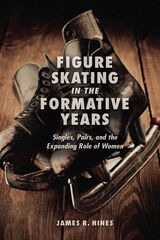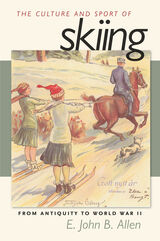The Culture and Sport of Skiing: From Antiquity to World War ll
University of Massachusetts Press, 2007
Paper: 978-1-55849-601-9 | eISBN: 978-1-61376-060-4 (institutional)
Library of Congress Classification GV854.1.A45 2007
Dewey Decimal Classification 796.93
Paper: 978-1-55849-601-9 | eISBN: 978-1-61376-060-4 (institutional)
Library of Congress Classification GV854.1.A45 2007
Dewey Decimal Classification 796.93
ABOUT THIS BOOK | AUTHOR BIOGRAPHY | REVIEWS | TOC
ABOUT THIS BOOK
A comprehensive history of skiing from its earliest origins to the outbreak of World War II, this book traces the transformation of what for centuries remained an exclusively utilitarian practice into the exhilarating modern sport we know today. E. John B. Allen places particular emphasis on the impact of culture on the development of skiing, from the influence of Norwegian nationalism to the role of the military in countries as far removed as Austria, India, and Japan. Although the focus is on Europe, Allen's analysis ranges all over the snow-covered world, from Algeria to China to Zakopane. He also discusses the participation of women and children in what for much of its history remained a male-dominated sport.
Of all the individuals who contributed to the modernization of skiing before World War II, Allen identifies three who were especially influential: Fridtjof Nansen of Norway, whose explorations on skis paradoxically inspired the idea of skiing as sport; Arnold Lunn of England, whose invention of downhill skiing and the slalom were foundations of the sport's globalization; and Hannes Schneider, whose teachings introduced both speed and safety into the sport.
Underscoring the extent to which ancient ways persisted despite modernization, the book ends with the Russo-Finnish War, a conflict in which the Finns, using equipment that would have been familiar a thousand years before, were able to maneuver in snow that had brought the mechanized Soviet army to a halt.
More than fifty images not only illustrate this rich history but provide further opportunity for analysis of its cultural significance.
Of all the individuals who contributed to the modernization of skiing before World War II, Allen identifies three who were especially influential: Fridtjof Nansen of Norway, whose explorations on skis paradoxically inspired the idea of skiing as sport; Arnold Lunn of England, whose invention of downhill skiing and the slalom were foundations of the sport's globalization; and Hannes Schneider, whose teachings introduced both speed and safety into the sport.
Underscoring the extent to which ancient ways persisted despite modernization, the book ends with the Russo-Finnish War, a conflict in which the Finns, using equipment that would have been familiar a thousand years before, were able to maneuver in snow that had brought the mechanized Soviet army to a halt.
More than fifty images not only illustrate this rich history but provide further opportunity for analysis of its cultural significance.
See other books on: Allen, E. John B. | Antiquity | Skiing | Skis and skiing | Sport
See other titles from University of Massachusetts Press





























